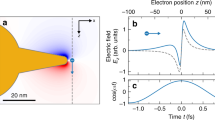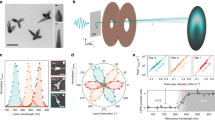Abstract
Plasmonic nanostructures concentrate optical fields into nanoscale volumes1,2, which is useful for plasmonic nanolasers3,4, surface enhanced Raman spectroscopy5,6 and white-light generation7. However, the short lifetimes of the emissive plasmons correspond to a rapid depletion of the plasmon energy, preventing further enhancement of local optical fields. Dark (subradiant) plasmons8,9,10,11,12 have longer lifetimes, but their resonant wavelengths cannot be tuned over a broad wavelength range without changing the overall geometry of the nanostructures. Also, fabrication of the nanostructures cannot be readily scaled because their complex shapes have subwavelength dimensions. Here, we report a new type of subradiant plasmon with a narrow (∼5 nm) resonant linewidth that can be easily tuned by changing the height of large (>100 nm) gold nanoparticles arranged in a two-dimensional array. At resonance, strong coupling between out-of-plane nanoparticle dipolar moments suppresses radiative decay, trapping light in the plane of the array and strongly localizing optical fields on each nanoparticle. This new mechanism can open up applications for subradiant plasmons because height-controlled nanoparticle arrays can be manufactured over wafer-scale areas on a variety of substrates.
This is a preview of subscription content, access via your institution
Access options
Subscribe to this journal
Receive 12 print issues and online access
$259.00 per year
only $21.58 per issue
Buy this article
- Purchase on Springer Link
- Instant access to full article PDF
Prices may be subject to local taxes which are calculated during checkout





Similar content being viewed by others
References
Maier, S. A. Plasmonics: Fundamentals and Applications (Springer, 2007).
Barnes, W. L., Dereux, A. & Ebbesen, T. W. Surface plasmon subwavelength optics. Nature 424, 824–830 (2003).
Noginov, M. A. et al. Demonstration of a spaser-based nanolaser. Nature 460, 1110–1168 (2009).
Oulton, R. F. et al. Plasmon lasers at deep subwavelength scale. Nature 461, 629–632 (2009).
Lim, D. K., Jeon, K. S., Kim, H. M., Nam, J. M. & Suh, Y. D. Nanogap-engineerable Raman-active nanodumbbells for single-molecule detection. Nature Mater. 9, 60–67 (2010).
Nie, S. M. & Emery, S. R. Probing single molecules and single nanoparticles by surface-enhanced Raman scattering. Science 275, 1102–1106 (1997).
Mühlschlegel, P., Eisler, H-J., Martin, O. J. F., Hecht, B. & Pohl, D. W. Resonant optical antennas. Science 308, 1607–1609 (2005).
Fedotov, V. A., Rose, M., Prosvirnin, S. L., Papasimakis, N. & Zheludev, N. I. Sharp trapped-mode resonances in planar metamaterials with a broken structural symmetry. Phys. Rev. Lett. 99, 147401 (2007).
Christ, A., Martin, O. J. F., Ekinci, Y., Gippius, N. A. & Tikhodeev, S. G. Symmetry breaking in a plasmonic metamaterial at optical wavelength. Nano Lett. 8, 2171–2175 (2008).
Hao, F. et al. Symmetry breaking in plasmonic nanocavities: subradiant LSPR sensing and a tunable Fano resonance. Nano Lett. 8, 3983–3988 (2008).
Fan, J. A. et al. Self-assembled plasmonic nanoparticle clusters. Science 328, 1135–1138 (2010).
Hentschel, M. et al. Transition from isolated to collective modes in plasmonic oligomers. Nano Lett. 10, 2721–2726 (2010).
Bohren, C. & Huffman, D. Absorption and Scattering of Light by Small Particles (Wiley-Interscience, 1998).
Link, S. & El-Sayed, M. A. Spectral properties and relaxation dynamics of surface plasmon electronic oscillations in gold and silver nanodots and nanorods. J. Phys. Chem. B 103, 8410–8426 (1999).
Voisin, C., Del Fatti, N., Christofilos, D. & Vallee, F. Ultrafast electron dynamics and optical nonlinearities in metal nanoparticles. J. Phys. Chem. B. 105, 2264–2280 (2001).
Sonnichsen, C. et al. Drastic reduction of plasmon damping in gold nanorods. Phys. Rev. Lett. 88, 077402 (2002).
Meier, M., Wokaun, A. & Liao, P. F. Enhanced fields on rough surfaces — dipolar interactions among particles of sizes exceeding the Rayleigh limit. J. Opt. Soc. Am. B 2, 931–949 (1985).
Lamprecht, B. et al. Metal nanoparticle gratings: influence of dipolar particle interaction on the plasmon resonance. Phys. Rev. Lett. 84, 4721–4724 (2000).
Zou, S. L., Janel, N. & Schatz, G. C. Silver nanoparticle array structures that produce remarkably narrow plasmon lineshapes. J. Chem. Phys. 120, 10871–10875 (2004).
Hicks, E. M. et al. Controlling plasmon line shapes through diffractive coupling in linear arrays of cylindrical nanoparticles fabricated by electron beam lithography. Nano Lett. 5, 1065–1070 (2005).
Hohenau, A. et al. Spectroscopy and nonlinear microscopy of Au nanoparticle arrays: experiment and theory. Phys. Rev. B 73, 155404 (2006).
Auguie, B. & Barnes, W. L. Collective resonances in gold nanoparticle arrays. Phys. Rev. Lett. 101, 143902 (2008).
Chu, Y. Z., Schonbrun, E., Yang, T. & Crozier, K. B. Experimental observation of narrow surface plasmon resonances in gold nanoparticle arrays. Appl. Phys. Lett. 93, 181108 (2008).
Kravets, V. G., Schedin, F. & Grigorenko, A. N. Extremely narrow plasmon resonances based on diffraction coupling of localized plasmons in arrays of metallic nanoparticles. Phys. Rev. Lett. 101, 087403 (2008).
Vecchi, G., Giannini, V. & Rivas, J. G. Surface modes in plasmonic crystals induced by diffractive coupling of nanoantennas. Phys Rev B 80, 201401 (2009).
Vecchi, G., Giannini, V. & Rivas, J. G. Shaping the fluorescent emission by lattice resonances in plasmonic crystals of nanoantennas. Phys. Rev. Lett. 102, 146807 (2009).
Fano, U. Effects of configuration interaction on intensities and phase shifts. Phys. Rev. 124, 1866–1878 (1961).
Hessel, A. & Oliner, A. A. A new theory of Wood's anomalies on optical gratings. Appl. Opt. 4, 1275–1297 (1965).
Henzie, J., Lee, M. H. & Odom, T. W. Multiscale patterning of plasmonic metamaterials. Nature Nanotech. 2, 549–554 (2007).
Johnson, P. B. & Christy, R. W. Optical-constants of noble-metals. Phys. Rev. B 6, 4370–4379 (1972).
Acknowledgements
The authors thank H. Gao and J-C. Yang for help with sample characterization and G. C. Schatz and S. Zou for discussions. This work was supported by the National Science Foundation (NSF) under CMMI-0826219 and the NSF-MRSEC program at the Materials Research Center at Northwestern University (DMR-0520513). This work made use of the NUANCE Center facilities, which are supported by NSF-MRSEC, NSF-NSEC and the Keck Foundation. Use of the Center for Nanoscale Materials was supported by the US Department of Energy, Office of Basic Energy Sciences (contract no. DE-AC02-06CH11357).
Author information
Authors and Affiliations
Contributions
T.W.O. and W.Z. conceived and designed the experiments. W.Z. performed the experiments, fabricated samples and performed numerical simulations. W.Z. and T.W.O. analysed the data and co-wrote the paper. Both authors discussed the results and commented on the manuscript.
Corresponding author
Ethics declarations
Competing interests
The authors declare no competing financial interests.
Supplementary information
Supplementary information
Supplementary information (PDF 1679 kb)
Rights and permissions
About this article
Cite this article
Zhou, W., Odom, T. Tunable subradiant lattice plasmons by out-of-plane dipolar interactions. Nature Nanotech 6, 423–427 (2011). https://doi.org/10.1038/nnano.2011.72
Received:
Accepted:
Published:
Issue Date:
DOI: https://doi.org/10.1038/nnano.2011.72
This article is cited by
-
Titanium Nitride Plasmonic Nanohole Arrays for CMOS-Compatible Integrated Refractive Index Sensing: Influence of Layer Thickness on Optical Properties
Plasmonics (2023)
-
The role of Rayleigh anomalies in the coupling process of plasmonic gratings and the control of the emission properties of organic molecules
Scientific Reports (2022)
-
Wavelength-Dependent Optical Chiralities of Symmetric and Asymmetric 2-Shaped Au Nanorod Structures at Nanoscales
Plasmonics (2020)
-
Design and applications of lattice plasmon resonances
Nano Research (2018)
-
Gold-Graphene Core-Shell Nanostructure Surface Plasmon Sensors
Plasmonics (2017)



